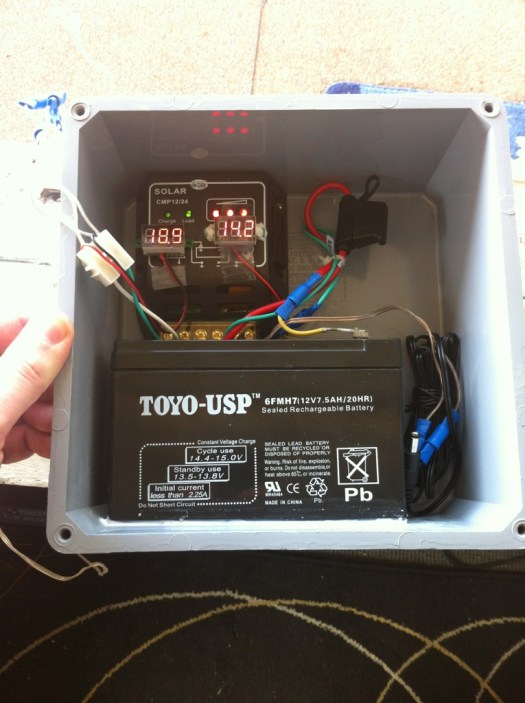I have built a solar powered Linksys WRT54g router setup.
1. WRT54g router 12v 1a with DDwrt v24 and HotSpotSystem.com ($20 ebay)
2. 10amp solar charger controller 12v ($10 ebay)
3. 2x 10watt solar panels 12v ($22 each ebay)
4. 1.4 Ah 12v battery ($16 Frys)
5. 20dB gain Yagi directional antenna ($10 ebay)
6. Reverse RP-TNC male to RP-SMA female adapter ($2 ebay)
7. (will purchase waterproof box) $10 or similar
RESULTS:
Works perfectly but needs a bigger battery. The 1.4Ah 12v sealed battery only lasts about 2 hours when the charge stops. I read somewhere that a 7.2Ah battery should work, which makes sense if I want to get roughly 7x more power time (if 1.4Ah=2hours then 7.2Ah should equal about 10 hours…)
The solar charge controller is awesome! Each panel puts out about 15-18v in medium cloudy sunlight at about 0.6amps each. The controller charges the battery to about 13.8v, then automatically switches to a float charge to about 14.1v. After full charge I could disconnect 1 panel and still maintain power to the router and a positive charge to the battery.
The panels are chinese 10Watt models from ebay. They seem to be pretty good, as it does not take much sunlight to generate 12-14v (in the medium shade). They will easily produce 18v each in full direct sunlight.
The Yagi is a 20 or 24 dB gain directional with a 30 degree cone spread signal. Haven’t done any testing as I am still in crutches after knee surgery and don’t want to go across the street and walk around.
Update:
Here is the 7.5 AH 12volt battery installed. The unit will power the WRT54G router for well over 8 hours. I put the whole thing in a waterproof box, however I am planning on drilling some holes for PVC pipes to vent and to affix the antennas to.
I found this cool Solar Powered Brewery bottlecap and decided it was perfect for a heatsink. So I glued it onto the main Broadcom chip for some heat dispersion.
Bottlecap heatsink on WRT54G router.
Installed in waterproof box. Must provide ventilation. Using stock antennas until the RP-TNC and RP-BNC adapters come in the mail.
Setup in action on a sunny day.
UPDATE:
I have put together an Arduino Solar Panel Sun Tracker. Check out the code and project page!













Awesome. As I commented on my other post I have been considering a similar project and just started looking for parts. Curious how your larger battery held up? I had estimates I’d want 2-3 days worth of charge to allow for low light, cloudy days etc.
It could use a bigger battery, the problem is the WRT54g takes 12v/1A. If you used a 5v router like the TP-Link WR703n, it would probably last for days (but lose Hotspotsystem.com firmware). I have been planning on getting a third 10w solar panel, I think this would keep the current setup on a solid 24/7 runtime.
also, you can get a 12v -> 5v regulated power converter for like $2 on eBay, if you wanted to power a 5v router from this 12v panel/battery/charger system.
So is your router hooked directly to the battery or is it hooked to the lamp power outlet of the charge controller?
Well, it is hooked to the ‘load’ outlet of the charge controller, not directly to the battery. I wouldn’t say its a ‘lamp’ outlet specifically, because there is no light/dark sensor that turns it on or off. The load outlet is just ‘on’ whenever there is enough battery or solar or both input
Great project. I looked around, but didn’t find one. Do you have a write up about HotSpotSystem? Pros and Cons?
Nice project. Since it’s 2015 now, may I ask if this setup worked for some time (or is still working?)
I consider using a PoE outdoor router (~80$), flashed with OpenWRT for building a open mesh network. It would simply be great to be able to use a solar panel/battery setup to feed it the juice needed. I could just put it out on the roof and forget about it.
The only problem I had was with DD-WRT and WDS/Mesh networking. Seems the version I was using only supported WEP encryption. Since I personally can crack WEP wifi networks in about 3-10 minutes, this was not an option for me. If you could get WDS or Mesh working with WPA, then I think you have a winning combo.